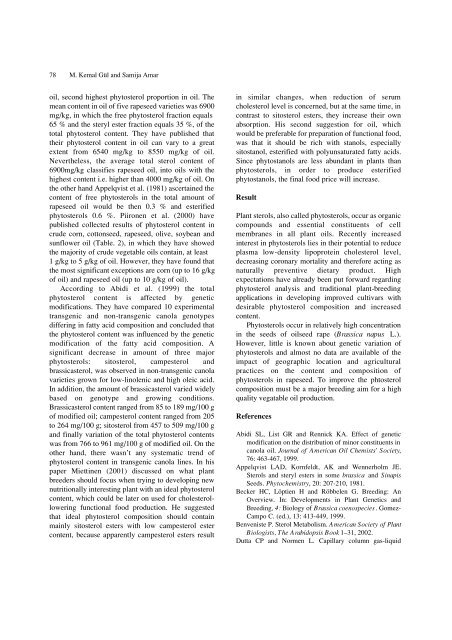Sterols and the phytosterol content in oilseed rape - Journal of Cell ...
Sterols and the phytosterol content in oilseed rape - Journal of Cell ...
Sterols and the phytosterol content in oilseed rape - Journal of Cell ...
Create successful ePaper yourself
Turn your PDF publications into a flip-book with our unique Google optimized e-Paper software.
78 M. Kemal Gül <strong>and</strong> Samija Amar<br />
oil, second highest <strong>phytosterol</strong> proportion <strong>in</strong> oil. The<br />
mean <strong>content</strong> <strong>in</strong> oil <strong>of</strong> five <strong>rape</strong>seed varieties was 6900<br />
mg/kg, <strong>in</strong> which <strong>the</strong> free <strong>phytosterol</strong> fraction equals<br />
65 % <strong>and</strong> <strong>the</strong> steryl ester fraction equals 35 %, <strong>of</strong> <strong>the</strong><br />
total <strong>phytosterol</strong> <strong>content</strong>. They have published that<br />
<strong>the</strong>ir <strong>phytosterol</strong> <strong>content</strong> <strong>in</strong> oil can vary to a great<br />
extent from 6540 mg/kg to 8550 mg/kg <strong>of</strong> oil.<br />
Never<strong>the</strong>less, <strong>the</strong> average total sterol <strong>content</strong> <strong>of</strong><br />
6900mg/kg classifies <strong>rape</strong>seed oil, <strong>in</strong>to oils with <strong>the</strong><br />
highest <strong>content</strong> i.e. higher than 4000 mg/kg <strong>of</strong> oil. On<br />
<strong>the</strong> o<strong>the</strong>r h<strong>and</strong> Appelqvist et al. (1981) ascerta<strong>in</strong>ed <strong>the</strong><br />
<strong>content</strong> <strong>of</strong> free <strong>phytosterol</strong>s <strong>in</strong> <strong>the</strong> total amount <strong>of</strong><br />
<strong>rape</strong>seed oil would be <strong>the</strong>n 0.3 % <strong>and</strong> esterified<br />
<strong>phytosterol</strong>s 0.6 %. Piironen et al. (2000) have<br />
published collected results <strong>of</strong> <strong>phytosterol</strong> <strong>content</strong> <strong>in</strong><br />
crude corn, cottonseed, <strong>rape</strong>seed, olive, soybean <strong>and</strong><br />
sunflower oil (Table. 2), <strong>in</strong> which <strong>the</strong>y have showed<br />
<strong>the</strong> majority <strong>of</strong> crude vegetable oils conta<strong>in</strong>, at least<br />
1 g/kg to 5 g/kg <strong>of</strong> oil. However, <strong>the</strong>y have found that<br />
<strong>the</strong> most significant exceptions are corn (up to 16 g/kg<br />
<strong>of</strong> oil) <strong>and</strong> <strong>rape</strong>seed oil (up to 10 g/kg <strong>of</strong> oil).<br />
Accord<strong>in</strong>g to Abidi et al. (1999) <strong>the</strong> total<br />
<strong>phytosterol</strong> <strong>content</strong> is affected by genetic<br />
modifications. They have compared 10 experimental<br />
transgenic <strong>and</strong> non-transgenic canola genotypes<br />
differ<strong>in</strong>g <strong>in</strong> fatty acid composition <strong>and</strong> concluded that<br />
<strong>the</strong> <strong>phytosterol</strong> <strong>content</strong> was <strong>in</strong>fluenced by <strong>the</strong> genetic<br />
modification <strong>of</strong> <strong>the</strong> fatty acid composition. A<br />
significant decrease <strong>in</strong> amount <strong>of</strong> three major<br />
<strong>phytosterol</strong>s: sitosterol, campesterol <strong>and</strong><br />
brassicasterol, was observed <strong>in</strong> non-transgenic canola<br />
varieties grown for low-l<strong>in</strong>olenic <strong>and</strong> high oleic acid.<br />
In addition, <strong>the</strong> amount <strong>of</strong> brassicasterol varied widely<br />
based on genotype <strong>and</strong> grow<strong>in</strong>g conditions.<br />
Brassicasterol <strong>content</strong> ranged from 85 to 189 mg/100 g<br />
<strong>of</strong> modified oil; campesterol <strong>content</strong> ranged from 205<br />
to 264 mg/100 g; sitosterol from 457 to 509 mg/100 g<br />
<strong>and</strong> f<strong>in</strong>ally variation <strong>of</strong> <strong>the</strong> total <strong>phytosterol</strong> <strong>content</strong>s<br />
was from 766 to 961 mg/100 g <strong>of</strong> modified oil. On <strong>the</strong><br />
o<strong>the</strong>r h<strong>and</strong>, <strong>the</strong>re wasn’t any systematic trend <strong>of</strong><br />
<strong>phytosterol</strong> <strong>content</strong> <strong>in</strong> transgenic canola l<strong>in</strong>es. In his<br />
paper Miett<strong>in</strong>en (2001) discussed on what plant<br />
breeders should focus when try<strong>in</strong>g to develop<strong>in</strong>g new<br />
nutritionally <strong>in</strong>terest<strong>in</strong>g plant with an ideal <strong>phytosterol</strong><br />
<strong>content</strong>, which could be later on used for cholesterollower<strong>in</strong>g<br />
functional food production. He suggested<br />
that ideal <strong>phytosterol</strong> composition should conta<strong>in</strong><br />
ma<strong>in</strong>ly sitosterol esters with low campesterol ester<br />
<strong>content</strong>, because apparently campesterol esters result<br />
<strong>in</strong> similar changes, when reduction <strong>of</strong> serum<br />
cholesterol level is concerned, but at <strong>the</strong> same time, <strong>in</strong><br />
contrast to sitosterol esters, <strong>the</strong>y <strong>in</strong>crease <strong>the</strong>ir own<br />
absorption. His second suggestion for oil, which<br />
would be preferable for preparation <strong>of</strong> functional food,<br />
was that it should be rich with stanols, especially<br />
sitostanol, esterified with polyunsaturated fatty acids.<br />
S<strong>in</strong>ce phytostanols are less abundant <strong>in</strong> plants than<br />
<strong>phytosterol</strong>s, <strong>in</strong> order to produce esterified<br />
phytostanols, <strong>the</strong> f<strong>in</strong>al food price will <strong>in</strong>crease.<br />
Result<br />
Plant sterols, also called <strong>phytosterol</strong>s, occur as organic<br />
compounds <strong>and</strong> essential constituents <strong>of</strong> cell<br />
membranes <strong>in</strong> all plant oils. Recently <strong>in</strong>creased<br />
<strong>in</strong>terest <strong>in</strong> <strong>phytosterol</strong>s lies <strong>in</strong> <strong>the</strong>ir potential to reduce<br />
plasma low-density lipoprote<strong>in</strong> cholesterol level,<br />
decreas<strong>in</strong>g coronary mortality <strong>and</strong> <strong>the</strong>refore act<strong>in</strong>g as<br />
naturally preventive dietary product. High<br />
expectations have already been put forward regard<strong>in</strong>g<br />
<strong>phytosterol</strong> analysis <strong>and</strong> traditional plant-breed<strong>in</strong>g<br />
applications <strong>in</strong> develop<strong>in</strong>g improved cultivars with<br />
desirable <strong>phytosterol</strong> composition <strong>and</strong> <strong>in</strong>creased<br />
<strong>content</strong>.<br />
Phytosterols occur <strong>in</strong> relatively high concentration<br />
<strong>in</strong> <strong>the</strong> seeds <strong>of</strong> <strong>oilseed</strong> <strong>rape</strong> (Brassica napus L.).<br />
However, little is known about genetic variation <strong>of</strong><br />
<strong>phytosterol</strong>s <strong>and</strong> almost no data are available <strong>of</strong> <strong>the</strong><br />
impact <strong>of</strong> geographic location <strong>and</strong> agricultural<br />
practices on <strong>the</strong> <strong>content</strong> <strong>and</strong> composition <strong>of</strong><br />
<strong>phytosterol</strong>s <strong>in</strong> <strong>rape</strong>seed. To improve <strong>the</strong> phtosterol<br />
composition must be a major breed<strong>in</strong>g aim for a high<br />
quality vegatable oil production.<br />
References<br />
Abidi SL, List GR <strong>and</strong> Rennick KA. Effect <strong>of</strong> genetic<br />
modification on <strong>the</strong> distribution <strong>of</strong> m<strong>in</strong>or constituents <strong>in</strong><br />
canola oil. <strong>Journal</strong> <strong>of</strong> American Oil Chemists’ Society,<br />
76: 463-467, 1999.<br />
Appelqvist LAD, Kornfeldt, AK <strong>and</strong> Wennerholm JE.<br />
<strong>Sterols</strong> <strong>and</strong> steryl esters <strong>in</strong> some brassica <strong>and</strong> S<strong>in</strong>apis<br />
Seeds. Phytochemistry, 20: 207-210, 1981.<br />
Becker HC, Löptien H <strong>and</strong> Röbbelen G. Breed<strong>in</strong>g: An<br />
O v e r v i e w. In: Developments <strong>in</strong> Plant Genetics <strong>and</strong><br />
Breed<strong>in</strong>g, 4: Biology <strong>of</strong> Brassica coenospecies. Gomez-<br />
Campo C. (ed.), 13: 413-449, 1999.<br />
Benveniste P. Sterol Metabolism. American Society <strong>of</strong> Plant<br />
Biologists, The Arabidopsis Book 1–31, 2002.<br />
Dutta CP <strong>and</strong> Normen L. Capillary column gas-liquid
















